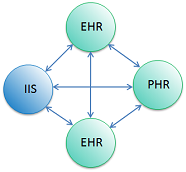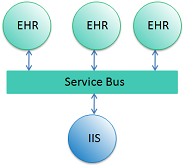Maximizing Return on Investment by Millions
From its inception, the MatchMerge Immunization Registry differentiated itself from other immunization registries by maintaining its own Matchmerge Patient Identification (MPI) and by preserving its incoming provider records in their original forms. In this sense, the MatchMerge registry as adopted by San Diego County (pop. 3M) behaves more like a specialized health information exchange with its own “edge server” containing unaltered copies of provider records, which it filters and presents for user consumption.
We then evolved our approach as Service-Oriented Architecture (SOA) technology developed. We broke our MatchMerge Services out separately so they could be combined with other software to create efficient new customer solutions as needed. For example, public health software vendor can combine our MatchMerge Decision Support (MDS) product with its system to permit public health departments to obtain multiple uses (outbreak management and immunization registry) from a single IT investment. Our Matchmerge Patient Identification (MPI) enables patient identification in such projects as San Diego’s Safety Net Connect.
Through our extensive standards work, we further expanded our technology to include evolving standard techniques such as Structured Documents (Continuity of Care Documents, C32, etc), developing a standards-based SOA reference architecture for immunization data exchange. The recognized Return on Investment of SOA is that, properly designed, it allows each participating system to make a single connection to a network, or carrier, that hides the complexity of combining and cascading service invocations within a “service bus” or similar mechanism. This reduces the complexity, and correspondingly, the cost, of healthcare interoperability by orders of magnitude.
A Service Oriented Architecture (SOA) approach saves 5 orders of magnitude.


